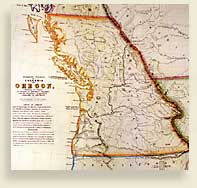Territorial Timeline

Oregon Provisional Government established
The treaty between the United States and Great Britain in 1818 provided for "Joint Occupancy" of Oregon, which at the time extended from Alaska to California and from the Rocky Mountains to the Pacific. While the Indians had their own tribal laws and the Hudson's Bay Company had its rules and regulations, the Americans in Oregon had no way of legally settling disputes.
When American settler Ewing Young died in 1841, there was no legal way to settle his estate. The other American settlers, some of whom were owed money by Young, decided that they must have some sort of government to solve such problems and to keep the peace. They met in February 1841, at the Lee Mission in the Willamette Valley where they elected a judge, a sheriff, two constables, a clerk and a recorder. They also attempted to draft a constitution but failed to agree on its provisions.
On February 2, 1843 the first of the so-called "Wolf Meetings" were held in the Willamette Valley to discuss the problem of wolves preying on livestock and other problems affecting the settlers. On May 2 they met at Champoeg, just south of present-day Portland. This time the meeting passed a resolution to adopt a provisional government and assign members of the meeting the task of drafting a legal code. Working from the only law book they had, an 1839 publication of the Statutes of Iowa (including the Northwest Ordinance of 1787), the settlers formed sub-committees to draft the proposed constitution.
On July 5, 1843, the settlers reassembled at Champoeg where they adopted a constitution, thus forming the Oregon Provisional Government. Although the Oregon Provisional Government may not have been legal, it served the settlers in Oregon until the establishment of Oregon Territory in 1848. One of the acts passed by the assembly recognized grain as legal tender.